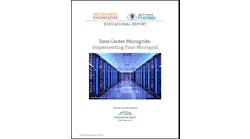California’s large influence on the energy industry bodes well for US microgrid growth, following the state’s passage last week of microgrid legislation that other states are likely to emulate, say industry players.
SB 1339 opens the door for creation of a microgrid tariff and predictable interconnection rules and time frames. Both create fairness and reduce risk, which should make it easier to finance projects, said David Chiesa, senior director of global business development at S&C Electric.
“What did we hear over and over at Microgrid 2018 from financiers? They want certainty. This bill establishes a fair degree of certainty. You know that within 180 days you will have an answer about interconnection. And you now can put into your proforma what the cost will be of having the utility there as a backup,” Chiesa said.
He added: “It’s like doing algebra. If you have one unknown in the equation, it’s an easy equation to solve. But it’s a whole other brand of math if you are doing multi-variant calculus. When you have multiple unknowns in the profit equation, it’s very difficult to figure out and there are is more inherent risks. This lowers the overall risk.”
Chiesa said that he was surprised utilities opposed the microgrid legislation, given that it removes a key concern some have expressed about microgrids. They fear facing a so-called “death spiral,” where customers exit the system to buy power from microgrids, leaving utilities with the requirement to ensure reliable electricity without revenue from sales to pay for it.
With a microgrid tariff in place, utilities will have an assured revenue stream to cover costs of required back-up power, Chiesa said.
“I don’t think this is a bad deal for anybody,” he said.
Chiesa also noted that Hawaii already instituted a similar law that served as a model for California. Given its bellwether status, and economic stature as the fifth largest economy, California is likely to encourage similar action on microgrids by other states. He compared the legislation to use of the power purchase agreement in solar, which spurred a sweep of solar development nationwide
“If the other PUCs see that this actually works, the playbook is written,” Chiesa said.
Mike Neylan, CEO of CellCube Energy Storage, also sees the bill becoming a model for other states.
“Given California’s leadership in establishing policies to deploy clean energy with energy storage, and energy storage being an integral component of clean energy microgrids, this is almost certainly to be the case,” he said.
Devil in details
Much depends on what happens next in California. Gov. Brown must sign the bill into law for it to go forward. And then state regulators will translate its provisions into regulation.
“In general, the bill requires a process to identify what is needed for microgrid deployment; it may be a tariff, it may be something else. I think this is a good thing. A tariff could have been too narrow and now we get to have a broad discussion about barriers/opportunities,” said Alex Porteshawver, distributed energy policy manager for the Center for Sustainable Energy.
She added that without the microgrid legislation, it’s unlikely that utilities would develop tariffs, regulations and guidelines for microgrids.
“In general, this highlights the value of microgrids, and creates a way to talk about accelerating development of them,” she said.
Next steps for microgrid legislation
From here, the California Public Utilities Commission (CPUC) will begin a regulatory proceeding, starting with a scoping memo, issued by one of more administrative law judges, that will create a schedule and issues to be addressed. It’s possible the CPUC will ask utilities to submit proposals, and then ask for feedback from interested parties, said Porteshawver.
“The bill does reference a working group to codify standards and protocols related to microgrids. So the commission will dictate how that working group is formed,” she said.
Dan Petersen, director of operations, market research and analystics for Atlas Retail Energy said that creating standards is an important goal of the microgrid legislation.
“Microgrids present tremendous value both from a reliability and cost standpoint but have to operate within a grid that wasn’t designed to keep up with this technology. Gathering utilities, developers and commissions to develop standards will alleviate some of these barriers to entry and hopefully quicken the timeline of these projects,” Petersen said.
Join us at Microgrid 2019, May 14-16 in San Diego, for an in-depth look at California’s microgrid legislation
Ken Robinson, director of business operations at Southland Energy, an energy services company sees challenges ahead in standardizing the connection between a microgrid and the larger grid.
“This will be challenging given the very wide range of potential configurations that a microgrid may have, as well as the specific condition of the grid at the point of connection. That said, to the extent that this succeeds in streamlining the interface, this will help speed the adoption of microgrids in general,” he said.
What will the tariffs look like?
By Who is Danny/Shutterstock.com
Industry members are anxious to see what the final tariffs or regulations will look like.
“It’s very difficult to predict the form of the tariff. While the intent is to encourage microgrids, there is also a provision that prevents costs ‘shifting’ between ratepayers, ie to or from the entities creating the microgrids,” said Robinson.
The costs and benefits of microgrids will likely be borne by the owner or operator, he noted.
“Whether this results in a higher or lower effective electrical rate will depend on the specific configuration and circumstances of the microgrid in question. It may be possible for the entire microgrid to operate as a whole entity in the context of a demand reduction program, which are already in existence,” he said.
Petersen added, “We anticipate seeing tariffs designed specifically for users within a microgrid. With the goal of not passing the cost of these projects onto other ratepayers, utilities will need to design tariffs that will address their cost to serve.”
Such tariffs would detail interconnection costs, reservation charges, and transmission costs, he said. Besides the cost of the actual equipment, utilities need to account for the cost to on standby for a location in the event equipment fails.
“Depending on size of a location’s output this may come in the form of a minimum demand charge labeled as a reserve charge. Since this is focused on 100 percent renewable sources I would imagine it would differ from the tariffs for standby service already in place,” Petersen said.
Overcoming obstacles
Tariffs that address utilities cost to serve microgrids now pose some obstacles. For example, California investor-owned utilities operate under California Electric Rule No. 2, which allows them to levy on customers a “cost of ownership” charge to recover the expenses for new grid infrastructure that supports the customers’ service. It’s unclear which microgrid components are included in this charge. This can make microgrids very expensive, and Porteshawver hopes that the new legislation will address the roadblock to development.
Under the microgrid legislation, within 180 days of a customer or developer’s first request to develop a microgrid in a public utility territory, the governing board of the publicly owned utility must develop a standardized process for interconnection, she said. This applies to smaller utilities with less than 100,000 service connections.
This is an exception for the small utilities that wouldn’t otherwise have to participate in the process created by the bill, she noted.
Calls for clean microgrids
By palidachan/Shutterstock.com
Industry members aren’t surprised by the fact that the microgrid legislation calls for clean microgrids.
“This cannot be a surprise to anyone,” said CellCube’s Neylan. “California is committed to 100% clean electricity by 2045 and this is just part of the broader societal evolution mandating the reduction of fossil fuels as a source of electricity generation.”
However, the legislation does include some exceptions to the clean microgrid rule, which prohibits the use of natural gas and diesel backups in microgrids. Health facilities such as hospitals are allowed to use diesel backup and standby system to meet health and safety code requirements, said
Porteshawver. This was added in response to feedback from hospitals and the military.
“The California bill takes great strides towards enabling microgrids with standardized procedures, but it is uncertain how the PUC will streamline the interconnection process and reduce costs,” added David Jones, manager at global consultancy for ICF. “The outcomes and impact of the no-fossil-fuel requirement will be evaluated over time, given the potential for efficient, low-emission CHP systems to balance renewable loads and provide resilient baseload power for microgrids.”
S&C’s Chiesa noted that once tariffs are imposed, they could delay projects in the works that were not able to factor them into financing. However, he says that is likely to be temporary with the new rules ultimately accelerating the market.
Elisa Wood contributed to this article.








